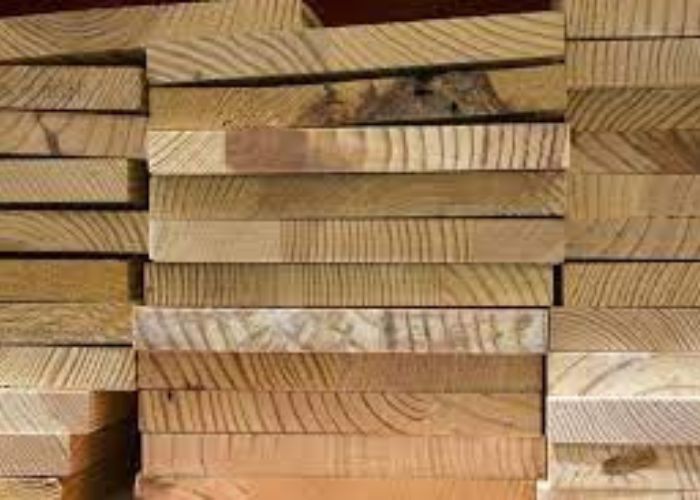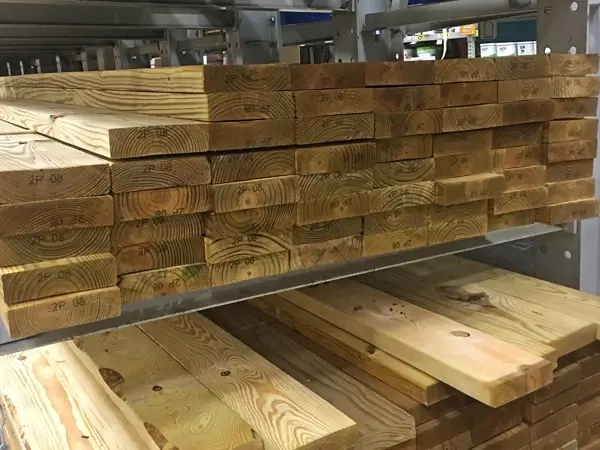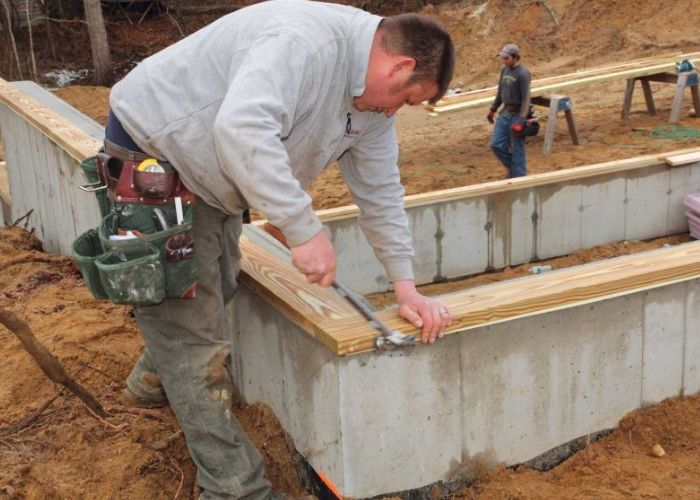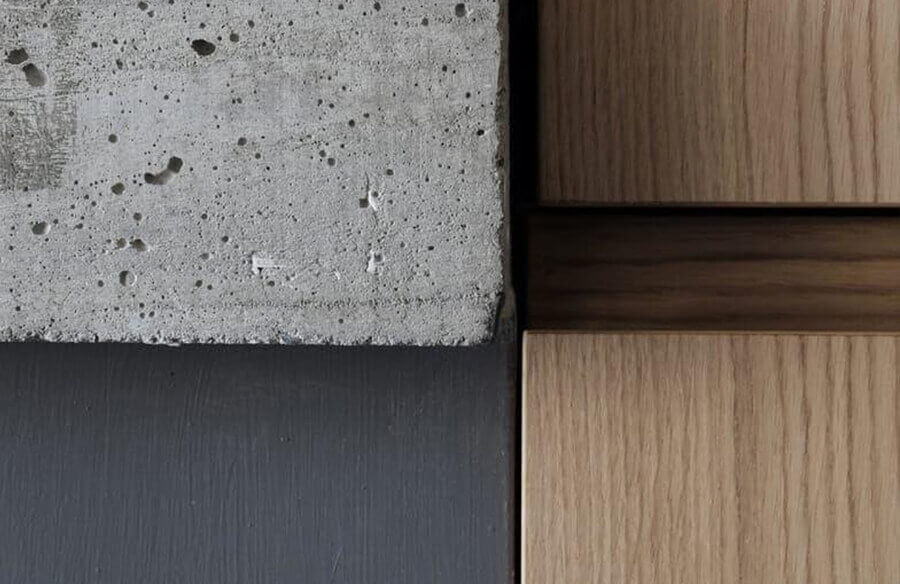Many people are trying to find the answer to “can you put pressure-treated wood directly on concrete?” The answer is yes, but there are a few things that you will need to do to make sure that your deck is stable and looks great.
This blog post will discuss everything you need to know about putting pressure-treated wood directly on concrete, from prep work to choosing the right materials.
Can You Put Pressure Treated Wood Directly on Concrete
Yes, you can put pressure-treated wood directly on concrete. First, ensure the concrete surface you are working on is smooth and level. Next, smoothen the surfaces with sandpaper and patch all cracks and holes using cement. Once the surface is prepared, you can start nailing the pressure-treated wood boards to the concrete.
What is Pressure Treated Wood?

Pressure-treated wood is a type of wood that has been specially treated to make it resistant to mildew, rot, and other forms of wear and tear.
This makes it an ideal material for outdoor applications such as decks and patios. There are several different types of pressure-treated wood, including cedar, pine, and spruce.
To ensure that your pressure-treated wood deck looks great and is stable, it is important to choose the right type of wood and follow the proper installation guidelines.
One key consideration when installing a pressure-treated wood deck directly on concrete is ensuring that the surface of the concrete is smooth and level.
You must note that pressure-treated wood is not suitable for every application. For example, it may not be suitable for making furniture or other smaller items.
Hence, you should always check the manufacturer’s guidelines before using pressure-treated wood in your project.
However, if you are looking for naturally durable wood for your deck or concrete patio, pressure-treated wood is an excellent option. (Find out the cost of wood deck vs concrete patio.)
When working with pressure-treated wood, make sure you wear proper protective gear. Also, remember burning pressure-treated wood is dangerous, so take care when disposing of it.
How Long will Pressure-Treated Wood Last in Concrete?
Pressure-treated wood can last up to 70 years when installed correctly on concrete. Therefore, it is important to choose high-quality pressure-treated wood and make sure that the surface of your concrete is smooth, level, and free from cracks and other blemishes.
To extend the lifespan of your pressure-treated wood deck, you can apply a layer of sealant or stain once the wood is fully installed. This will help protect your deck from moisture and other elements, helping it to last for years to come.
So, if you are looking for a durable and long-lasting material for your outdoor deck or patio, pressure-treated wood is an excellent option. Just take the necessary steps to ensure that your deck is installed correctly and lasts for many years.
Will Concrete Rot Pressure-Treated Wood?
No. Concrete will not rot pressure-treated wood. Pressure treated wood is ideal for outdoor applications such as decks and patios because it is resistant to rot and other forms of wear and tear.
However, it is important to take the necessary steps to prepare the concrete surface before installing pressure-treated wood. Once the concrete surface is prepared, you can start nailing the pressure-treated wood boards to the concrete.

Is there a way to prevent wood rot. Yes, read our article on how to prevent wood from rotting outside to learn more.
Uses of Pressure Treated Wood
You don’t want to spend time and effort on a beautiful deck only to have it collapse in a few years. Pressure-treated wood is a good material for a deck.
Of course, you must be cautious about the pressure-treated wood you use. There may be instances when you utilize a more heavily treated wood for the foundation and a lesser concentrated product for the rails and floors.
Also, seal your treated wood with a penetrant oil-based stain for further protection from pressure-treated wood.
Pressure-treated lumber can also make sheds, playgrounds, and other outdoor structures. In addition, lumber is often used for the framing of these structures. But can you use treated wood for indoor projects?
When deciding on what type of pressure-treated lumber to use, you should consider the following:
– The thickness of the lumber. Heavier lumber is better suited for frameworks and other load-bearing applications.
– The grade of the lumber. Higher grades are less likely to warp and twist.
– The pressure treatment level of the lumber. You’ll want to use lumber that has been treated for both wood rot and insects.
If you’re unsure what type of pressure-treated lumber to use, you should consult with a qualified contractor or building supply specialist.
Read also: Does pressure treated wood rot?
Types of Pressure Treated Wood
There are three types of pressure-treated wood. The type you use will be based on the location of your project.
Above ground level
This type of pressure-treated wood has the lowest level of preservative. The lumber is often used for decks, fences, and other outdoor structures not in direct contact with the ground. It usually lasts about 15-20 years.
Ground contact
Ground contact lumber is for projects that touch the ground or constantly have soil around it, such as decks, fences, and porches. This lumber can last up to 40 years.
Some projects may only require certain parts to be ground contact lumber, while others may need the entire project to be made from it. If a building code is required for your project, check what it says about ground contact lumber.
Marine-grade
Marine-grade pressure-treated lumber is for projects in direct contact with water, such as docks, piers, and boat ramps. This lumber has been pressure treated to resist wood rot and decay caused by insects and water.
While in water, it can last up to 20 years. Out of the water, it can last 40 years. Like ground contact lumber, some projects may only require certain parts to be marine-grade, while others may need the entire project to be made from it.
Remember to check your project’s building code to see what it says about marine-grade lumber.
In-ground contact for critical uses
Pressure-treated lumber is specially made for in-ground contact that can last over 40 years. These uses are for telephone poles, light posts, and fence posts.
This lumber is pressure treated with a preservative containing copper and chromium. The levels of these two chemicals make the lumber toxic to insects and fungi, which helps the lumber last a long time underground.
Types of Wood Preservatives
There are four common types of wood preservatives. These are:
1. Chromated Copper Arsenate (CCA)
This is the most common type of wood preservative. It is made from a mixture of chromium, copper, and arsenic.
CCA is rot and decay-resistant wood. It is often used for projects in direct contact with the ground, such as decks, fences, and porch posts.
The level of CCA can range from .25% to .40%. The higher the level of CCA, the longer the lumber will last.
However, CCA-treated lumber is no longer being manufactured in the United States. This is because CCA contains arsenic, which is a poisonous chemical.
2. Borate
Borate is a naturally occurring element that effectively prevents wood rot and decay caused by insects and fungi.
It is often used for above-ground projects, such as decks, fences, and wood porches. Borate-treated lumber can last up to 20 years.
3. Micronized Copper Azole (MCA)
MCA is made from a mixture of copper and zinc. It is effective at preventing rot and decay caused by insects and fungi.
MCA-treated lumber can be used for both above-ground and ground contact projects. Some types of MCA-treated lumber can last up to 40 years.
4. Alkaline Copper Quaternary (ACQ)
ACQ is made from a mixture of copper and zinc. It effectively prevents wood rot and decay caused by insects and fungi. ACQ-treated lumber can last up to 40 years.
How Do You Attach Pressure Treated Wood to Concrete?

Tools and materials needed:
- Drill
- Screws (galvanized or stainless steel)
- Concrete anchors
- Screwdriver
- Marker/pencil
- Hammer
- Fasteners
- Concrete nails
Preparation
Before attaching pressure-treated wood to concrete, it is important to prepare the surface of the concrete properly. This involves ensuring that the concrete is smooth and level and patching any cracks or holes using cement.
Step 1: Measuring the holes
Measure the holes that you will be attaching to the pressure-treated wood. Using a marker or pencil, mark the spots where you plan to drill and attach your screws.
This will help you make accurate holes in the concrete and ensure that your pressure-treated wood is properly secured to the concrete.
Step 2: Drilling pilot holes
Using a drill, drill small pilot holes into the surface of the concrete at each marked spot. This helps prevent the concrete from cracking when you attach the screws.
Ensure the holes are the same depth as the fasteners you will be using. Also, make them as neat and clean as possible.
Step 3: Attaching the concrete anchors
Attach the concrete anchors to the holes using a screwdriver. Make sure that the anchors are flush with the surface of the concrete.
Step 4: Attaching the pressure-treated wood
Using screws, attach the pressure-treated wood to the concrete at each anchor point. Be careful not to overtighten the screws, as this may damage the concrete.
Step 5: Tightening and checking
Tighten the screws until they are flush with the surface of the pressure-treated wood. Check to ensure that the pressure-treated wood is securely attached to the concrete before moving on to the next step.
Once your pressure-treated wood is securely attached to the concrete, you can begin using your deck or patio for all your outdoor projects!
How to Protect Wood from Concrete
To protect the wood from concrete, your first step should be to choose high-quality pressure-treated wood appropriate for the surface of your concrete.
This will help ensure that the wood can withstand exposure to moisture and other elements over time.
To protect treated wood from cracking or deteriorating, you may also want to apply a layer of sealant or stain to the surface of your pressure-treated wood.
This will help create a moisture barrier between the wood and the concrete. If you take these steps, you can be sure that your pressure-treated wood will last for many years to come.
Also Read: Can You Use Concrete Paint on Wood?
FAQs
What do you put between wood and concrete?
Various materials can fill the space between wood and concrete, including asphalt, fiberglass, foam board, mineral wool, and polyurethane. Each material has its own set of benefits and drawbacks. For example, asphalt is a waterproof moisture barrier that can help protect the wood from wick moisture, while fiberglass is ideal for thermal insulation.
Can you put wood directly on concrete?
Yes, you can put wood directly on concrete. First, if the concrete is new, you’ll want to wait at least 28 days before finishing it. This gives the concrete time to cure properly. Second, if the concrete is old or has been damaged, you’ll want to make sure it’s clean and free of any debris or contaminants that could prevent the wood from adhering properly. Third, if you’re going to be putting a heavy load on the wood, you may want to use some sort of anchors or supports to keep it from sliding or shifting.
How long will non-treated wood last on concrete?
Non-treated wood outdoors will last a few months to a few years on concrete. The exact lifespan depends on the type of wood, sunlight and moisture exposure, and other factors. If you want your wood to last longer, you can try sealing it with a waterproof sealant or stain.
Read: Can you use wood stain on concrete?
Does wood rot in concrete?
Yes, wood can rot in concrete. However, any organic material can rot in concrete if enough moisture is present. This is because the alkaline nature of concrete neutralizes acids and creates an ideal environment for mold and bacteria to grow for lumber used in a concrete project, treated with a water-resistant sealant to protect it from rotting.
Here is an article that will guide you on how to tell if wood is treated or untreated.
Conclusion
So, can you put pressure treated wood directly on concrete? Yes, you can. Ensure you consider what we have discussed in this article to have a long-lasting project.
I hope all your questions regarding pressure-treated lumber and concrete have been answered.
Please leave comments in the section below.

